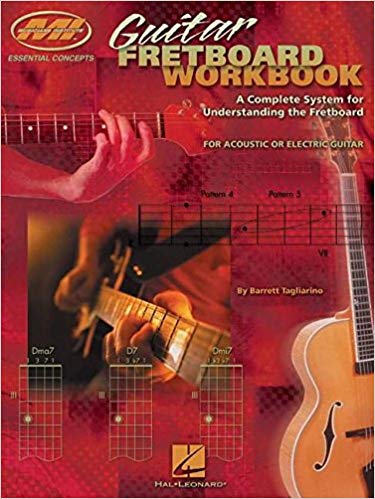 Guitar Fretboard Workbook: A Complete System for Understanding the Fretboard. Guitar Fretboard Workbook: A Complete System for Understanding the Fretboard.
Do you ever get lost on the fretboard and have to stop playing and jump to a familiar box shape, losing your train of thought? Ever feel like you're just playing the same scales in the same positions, with a limited vocabulary of options? This can happen partly because the guitar presents challenges other instruments don't have. The notes are not always where your fingers expect them to be! Each chord and scale has multiple fretboard shapes, depending on position and strings, each with multiple possible fingerings. It can be seriously frustrating at times. However, it IS possible to easily understand the fretboard layout so you can find what you want to hear without stopping to think. There was a time when I thought I just didn't have the motivation and brain power to memorize the notes on the neck using the chart my first teacher gave me. You may have seen it: a giant 15-fret six-string diagram with 90 note names on it. My eyes would glaze over. Even if I did memorize all the note names, what would that get me? Would I have to start over with memorizing a full-neck diagram for each new scale and chord? When I enrolled at Musicians Institute (MI---it was called GIT back then) in 1984, I learned that there's a much easier way to think about the guitar fretboard. My playing improved massively in a matter of months. I started teaching at MI shortly after graduation, and in the decades since I've helped thousands of MI students experience the same fretboard epiphanies. In 2002 I decided to distill the system we use there into a workbook that you can use to teach yourself. And it works. So far there are about 500 product reviews of the Guitar Fretboard Workbook at Amazon from people all over the world, grateful for the help getting over the fretboard hurdle. People email me asking for clarification of topics in the book (or outside of it), and I always read and answer them all. Clicking this link will take you to Amazon where you can see the reviews and make your buying decision. For this book I recommend the paperback version, not the kindle version. I know it's a little less convenient, but once you've seen how a scale or chord is constructed using the basic intervals on the neck, the act of completing the diagrams yourself helps you learn it much faster than just looking at them while you play. You'll probably want to keep the workbook where you can easily grab it for years to come. If you're not sure you want to buy the book just yet, you can click here to subscribe to my youtube channel where I post frequent videos based on content from this and my other books. In each video you'll get a helpful exercise, an important universal concept, a practical lick you can actually use, or just something fun to play that'll make you want to pick up your guitar whenever you can! Of course you can also find this book at BarnesandNoble.com or any other bookseller, and probably on Ebay for a rock-bottom price. The real cost is not the price of the book; it's the time you'll be investing if you want to break through the fretboard navigation barrier. About 15 minutes of work per day for 2 months will start to show you some clear results. By then I'm sure you'll think it was well worth it. There are always some guitarists who get stuck in a rut of mediocrity, not improving for years because they never bothered to learn the basics. I feel bad for them because they miss out on musical moments all players should enjoy. There should be a steady transition from "clumsy yet motivated beginner" to "accomplished mind-blowing master," and experience has shown me everyone can do it. |